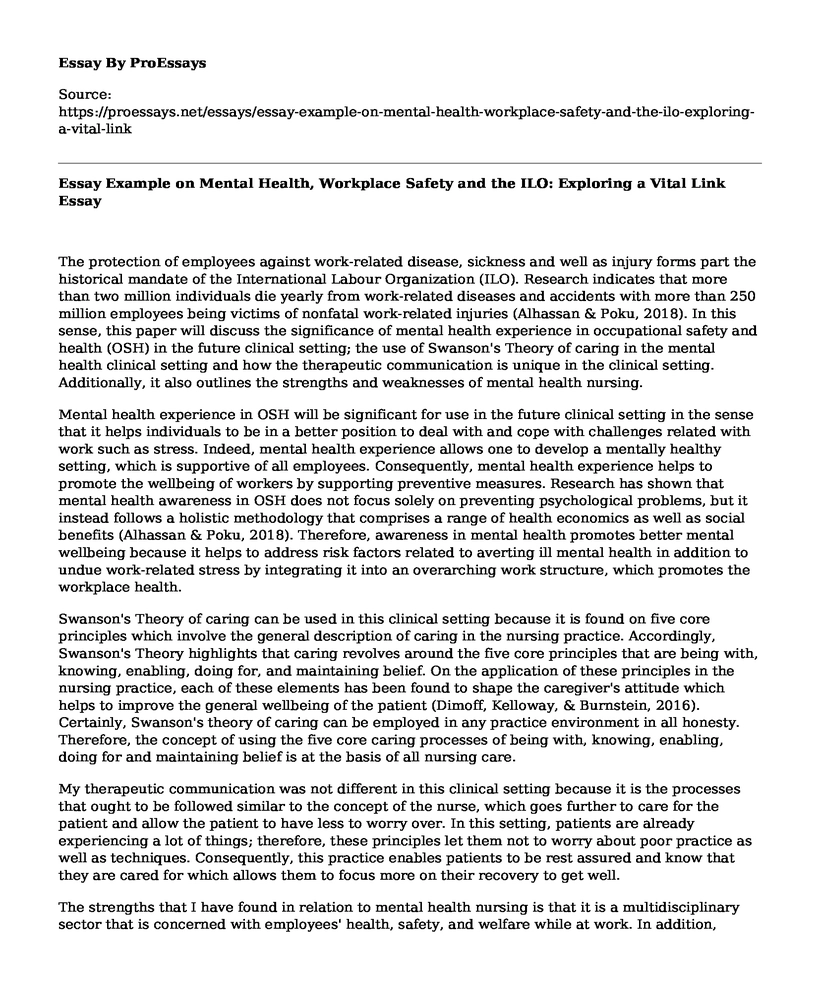The protection of employees against work-related disease, sickness and well as injury forms part the historical mandate of the International Labour Organization (ILO). Research indicates that more than two million individuals die yearly from work-related diseases and accidents with more than 250 million employees being victims of nonfatal work-related injuries (Alhassan & Poku, 2018). In this sense, this paper will discuss the significance of mental health experience in occupational safety and health (OSH) in the future clinical setting; the use of Swanson's Theory of caring in the mental health clinical setting and how the therapeutic communication is unique in the clinical setting. Additionally, it also outlines the strengths and weaknesses of mental health nursing.
Mental health experience in OSH will be significant for use in the future clinical setting in the sense that it helps individuals to be in a better position to deal with and cope with challenges related with work such as stress. Indeed, mental health experience allows one to develop a mentally healthy setting, which is supportive of all employees. Consequently, mental health experience helps to promote the wellbeing of workers by supporting preventive measures. Research has shown that mental health awareness in OSH does not focus solely on preventing psychological problems, but it instead follows a holistic methodology that comprises a range of health economics as well as social benefits (Alhassan & Poku, 2018). Therefore, awareness in mental health promotes better mental wellbeing because it helps to address risk factors related to averting ill mental health in addition to undue work-related stress by integrating it into an overarching work structure, which promotes the workplace health.
Swanson's Theory of caring can be used in this clinical setting because it is found on five core principles which involve the general description of caring in the nursing practice. Accordingly, Swanson's Theory highlights that caring revolves around the five core principles that are being with, knowing, enabling, doing for, and maintaining belief. On the application of these principles in the nursing practice, each of these elements has been found to shape the caregiver's attitude which helps to improve the general wellbeing of the patient (Dimoff, Kelloway, & Burnstein, 2016). Certainly, Swanson's theory of caring can be employed in any practice environment in all honesty. Therefore, the concept of using the five core caring processes of being with, knowing, enabling, doing for and maintaining belief is at the basis of all nursing care.
My therapeutic communication was not different in this clinical setting because it is the processes that ought to be followed similar to the concept of the nurse, which goes further to care for the patient and allow the patient to have less to worry over. In this setting, patients are already experiencing a lot of things; therefore, these principles let them not to worry about poor practice as well as techniques. Consequently, this practice enables patients to be rest assured and know that they are cared for which allows them to focus more on their recovery to get well.
The strengths that I have found in relation to mental health nursing is that it is a multidisciplinary sector that is concerned with employees' health, safety, and welfare while at work. In addition, mental health awareness plays a critical role among workers in the occupational safety and health in their place of work since it is a measure that supports better mental wellbeing (Dimoff, Kelloway, & Burnstein, 2016). Mental health experience helps to nurture a sustainable approach for the welfare of workers because it focuses on mental health, lifestyle, and physical health.
I wish that I was better at Swanson's Theory of caring because it works to see to it that the patient is well cared for through the five core principles.
References
Alhassan, R. K., & Poku, K. A. (2018). Experiences of frontline nursing staff on workplace safety and occupational health hazards in two psychiatric hospitals in Ghana. BMC public health, 18(1), 701.
Dimoff, J. K., Kelloway, E. K., & Burnstein, M. D. (2016). Mental health awareness training (MHAT): The development and evaluation of an intervention for workplace leaders. International Journal of Stress Management, 23(2), 167.
Cite this page
Essay Example on Mental Health, Workplace Safety and the ILO: Exploring a Vital Link. (2023, Jan 11). Retrieved from https://proessays.net/essays/essay-example-on-mental-health-workplace-safety-and-the-ilo-exploring-a-vital-link
If you are the original author of this essay and no longer wish to have it published on the ProEssays website, please click below to request its removal:
- Essay on Yoga for Overall Good Health
- Job Rotation Case Study Paper Example
- Essay on Biological and Cognitive Perspectives of Psychology: Analysing Behaviour
- Essay Example on Self-Monitoring Skills: Regulating Emotions for Better Relationships
- What is Friendship?: Plato's Lysis Dialogue Explores Definitions - Essay Sample
- Addiction: A Study of Career Counseling in Relation to Holland and Work Adjustment Theories - Essay Sample
- Bipolar Disorder: Historical Background, Causes, Symptoms & More - Research Paper







